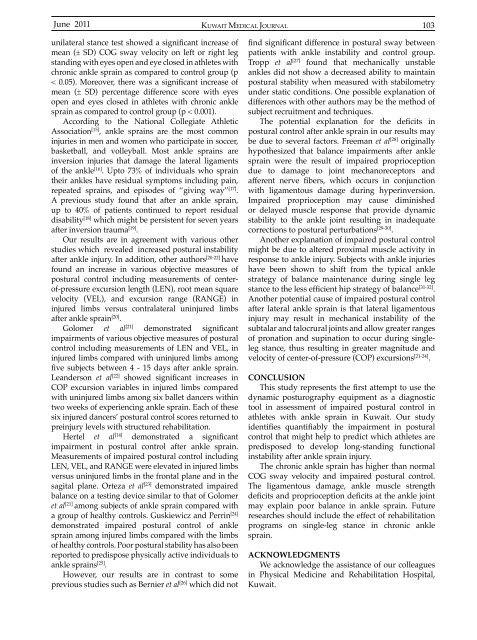Vol 43 # 2 June 2011 - Kma.org.kw
Vol 43 # 2 June 2011 - Kma.org.kw
Vol 43 # 2 June 2011 - Kma.org.kw
Create successful ePaper yourself
Turn your PDF publications into a flip-book with our unique Google optimized e-Paper software.
<strong>June</strong> <strong>2011</strong><br />
KUWAIT MEDICAL JOURNAL 103<br />
unilateral stance test showed a significant increase of<br />
mean (± SD) COG sway velocity on left or right leg<br />
standing with eyes open and eye closed in athletes with<br />
chronic ankle sprain as compared to control group (p<br />
< 0.05). Moreover, there was a significant increase of<br />
mean (± SD) percentage difference score with eyes<br />
open and eyes closed in athletes with chronic ankle<br />
sprain as compared to control group (p < 0.001).<br />
According to the National Collegiate Athletic<br />
Association [15] , ankle sprains are the most common<br />
injuries in men and women who participate in soccer,<br />
basketball, and volleyball. Most ankle sprains are<br />
inversion injuries that damage the lateral ligaments<br />
of the ankle [16] . Upto 73% of individuals who sprain<br />
their ankles have residual symptoms including pain,<br />
repeated sprains, and episodes of ‘‘giving way’’ [17] .<br />
A previous study found that after an ankle sprain,<br />
up to 40% of patients continued to report residual<br />
disability [18] which might be persistent for seven years<br />
after inversion trauma [19] .<br />
Our results are in agreement with various other<br />
studies which revealed increased postural instability<br />
after ankle injury. In addition, other authors [20-22] have<br />
found an increase in various objective measures of<br />
postural control including measurements of centerof-pressure<br />
excursion length (LEN), root mean square<br />
velocity (VEL), and excursion range (RANGE) in<br />
injured limbs versus contralateral uninjured limbs<br />
after ankle sprain [20] .<br />
Golomer et al [21] demonstrated significant<br />
impairments of various objective measures of postural<br />
control including measurements of LEN and VEL, in<br />
injured limbs compared with uninjured limbs among<br />
five subjects between 4 - 15 days after ankle sprain.<br />
Leanderson et al [22] showed significant increases in<br />
COP excursion variables in injured limbs compared<br />
with uninjured limbs among six ballet dancers within<br />
two weeks of experiencing ankle sprain. Each of these<br />
six injured dancers’ postural control scores returned to<br />
preinjury levels with structured rehabilitation.<br />
Hertel et al [14] demonstrated a significant<br />
impairment in postural control after ankle sprain.<br />
Measurements of impaired postural control including<br />
LEN, VEL, and RANGE were elevated in injured limbs<br />
versus uninjured limbs in the frontal plane and in the<br />
sagital plane. Orteza et al [23] demonstrated impaired<br />
balance on a testing device similar to that of Golomer<br />
et al [21] among subjects of ankle sprain compared with<br />
a group of healthy controls. Guskiewicz and Perrin [24]<br />
demonstrated impaired postural control of ankle<br />
sprain among injured limbs compared with the limbs<br />
of healthy controls. Poor postural stability has also been<br />
reported to predispose physically active individuals to<br />
ankle sprains [25] .<br />
However, our results are in contrast to some<br />
previous studies such as Bernier et al [26] which did not<br />
find significant difference in postural sway between<br />
patients with ankle instability and control group.<br />
Tropp et al [27] found that mechanically unstable<br />
ankles did not show a decreased ability to maintain<br />
postural stability when measured with stabilometry<br />
under static conditions. One possible explanation of<br />
differences with other authors may be the method of<br />
subject recruitment and techniques.<br />
The potential explanation for the deficits in<br />
postural control after ankle sprain in our results may<br />
be due to several factors. Freeman et al [28] originally<br />
hypothesized that balance impairments after ankle<br />
sprain were the result of impaired proprioception<br />
due to damage to joint mechanoreceptors and<br />
afferent nerve fibers, which occurs in conjunction<br />
with ligamentous damage during hyperinversion.<br />
Impaired proprioception may cause diminished<br />
or delayed muscle response that provide dynamic<br />
stability to the ankle joint resulting in inadequate<br />
corrections to postural perturbations [29-30] .<br />
Another explanation of impaired postural control<br />
might be due to altered proximal muscle activity in<br />
response to ankle injury. Subjects with ankle injuries<br />
have been shown to shift from the typical ankle<br />
strategy of balance maintenance during single leg<br />
stance to the less efficient hip strategy of balance [31-32] .<br />
Another potential cause of impaired postural control<br />
after lateral ankle sprain is that lateral ligamentous<br />
injury may result in mechanical instability of the<br />
subtalar and talocrural joints and allow greater ranges<br />
of pronation and supination to occur during singleleg<br />
stance, thus resulting in greater magnitude and<br />
velocity of center-of-pressure (COP) excursions [21-24] .<br />
CONCLUSION<br />
This study represents the first attempt to use the<br />
dynamic posturography equipment as a diagnostic<br />
tool in assessment of impaired postural control in<br />
athletes with ankle sprain in Kuwait. Our study<br />
identifies quantifiably the impairment in postural<br />
control that might help to predict which athletes are<br />
predisposed to develop long-standing functional<br />
instability after ankle sprain injury.<br />
The chronic ankle sprain has higher than normal<br />
COG sway velocity and impaired postural control.<br />
The ligamentous damage, ankle muscle strength<br />
deficits and proprioception deficits at the ankle joint<br />
may explain poor balance in ankle sprain. Future<br />
researches should include the effect of rehabilitation<br />
programs on single-leg stance in chronic ankle<br />
sprain.<br />
ACKNOWLEDGMENTS<br />
We acknowledge the assistance of our colleagues<br />
in Physical Medicine and Rehabilitation Hospital,<br />
Kuwait.
















